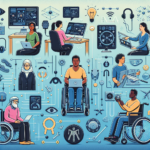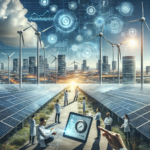-
Table of Contents
“Revolutionizing Agriculture: Harnessing Technology for a Sustainable Future”
Introduction
The integration of technology into agriculture is revolutionizing the way we grow, manage, and harvest crops, leading to increased efficiency, sustainability, and productivity. Precision agriculture, which utilizes GPS technology, drones, and IoT sensors, allows farmers to monitor crop health, soil conditions, and weather patterns in real-time, enabling data-driven decisions that optimize resource use and reduce waste. Advanced machinery and automation, such as autonomous tractors and robotic harvesters, streamline labor-intensive tasks, enhancing operational efficiency. Biotechnology innovations, including genetically modified organisms (GMOs) and CRISPR gene editing, are improving crop resilience and yield. Additionally, digital platforms and mobile apps provide farmers with access to market information, weather forecasts, and best practices, fostering informed decision-making. Collectively, these technological advancements are transforming agriculture into a more sustainable and productive industry, capable of meeting the growing global food demand.
Precision Farming: Leveraging GPS and IoT for Efficient Crop Management
In the heart of the agricultural revolution, precision farming is emerging as a beacon of hope for farmers worldwide. This innovative approach leverages cutting-edge technologies such as GPS and the Internet of Things (IoT) to enhance crop management, promising not only increased efficiency but also sustainability. As the global population continues to swell, the demand for food production intensifies, making the adoption of these advanced techniques not just beneficial but essential.
At the core of precision farming lies the integration of GPS technology. By utilizing satellite positioning systems, farmers can now map their fields with remarkable accuracy. This allows for the precise application of inputs like seeds, fertilizers, and pesticides, ensuring that each plant receives the optimal amount of resources. Consequently, this targeted approach minimizes waste and reduces the environmental impact, addressing concerns about overuse of chemicals and soil degradation. Moreover, GPS-guided machinery can operate with unparalleled precision, reducing overlaps and missed areas, which translates to significant cost savings and improved yields.
Transitioning to the role of IoT in agriculture, the synergy between connected devices and data analytics is transforming how farmers monitor and manage their crops. IoT sensors placed throughout the fields collect real-time data on soil moisture, temperature, humidity, and other critical parameters. This wealth of information is then transmitted to centralized systems where it is analyzed to provide actionable insights. For instance, farmers can receive alerts on their smartphones about areas that require irrigation or are at risk of pest infestations. This timely information enables them to make informed decisions, enhancing crop health and productivity.
Furthermore, the integration of drones equipped with advanced imaging technologies is revolutionizing crop surveillance. These aerial devices can capture high-resolution images and multispectral data, revealing patterns and anomalies that are invisible to the naked eye. By analyzing this data, farmers can identify issues such as nutrient deficiencies, disease outbreaks, and water stress early on. This proactive approach allows for swift intervention, preventing minor problems from escalating into major threats to crop yields.
In addition to improving crop management, precision farming technologies are fostering a more sustainable agricultural ecosystem. The efficient use of resources not only conserves water and reduces chemical runoff but also lowers greenhouse gas emissions. As farmers adopt these practices, they contribute to the broader goal of mitigating climate change and preserving natural habitats. This alignment with environmental stewardship resonates with consumers who are increasingly conscious of the ecological footprint of their food.
However, the transition to precision farming is not without its challenges. The initial investment in technology and training can be a significant barrier for small-scale farmers. Additionally, the complexity of managing and interpreting vast amounts of data requires a certain level of expertise. To address these issues, governments and agricultural organizations are stepping in to provide financial support and educational programs. By fostering collaboration and knowledge sharing, they aim to democratize access to these transformative tools.
In conclusion, the advent of precision farming, powered by GPS and IoT, is reshaping the agricultural landscape. By enabling more efficient and sustainable crop management, these technologies hold the promise of meeting the growing food demands of the future. As farmers navigate this technological frontier, they are not only enhancing their productivity but also contributing to a more resilient and environmentally conscious agricultural system. The journey may be fraught with challenges, but the potential rewards make it a path worth pursuing.
Drones in Agriculture: Enhancing Crop Monitoring and Pest Control
In the ever-evolving landscape of agriculture, technology has become an indispensable ally, revolutionizing traditional practices and offering innovative solutions to age-old problems. Among the myriad advancements, drones have emerged as a particularly transformative tool, enhancing crop monitoring and pest control in ways that were previously unimaginable. As farmers grapple with the challenges of climate change, resource scarcity, and the need for sustainable practices, drones offer a beacon of hope, promising increased efficiency and productivity.
The integration of drones into agricultural practices is not merely a futuristic concept but a present-day reality that is reshaping the industry. These unmanned aerial vehicles (UAVs) are equipped with advanced sensors and imaging capabilities, allowing farmers to gain a bird’s-eye view of their fields. This aerial perspective is invaluable for crop monitoring, as it provides detailed insights into plant health, soil conditions, and overall field performance. By capturing high-resolution images and generating precise data, drones enable farmers to identify issues such as nutrient deficiencies, water stress, and disease outbreaks with unprecedented accuracy.
Transitioning from traditional methods to drone-assisted monitoring offers several advantages. For one, it significantly reduces the time and labor required to survey large tracts of land. Instead of manually inspecting fields, which can be both time-consuming and physically demanding, farmers can now deploy drones to conduct comprehensive assessments in a fraction of the time. This efficiency not only saves labor costs but also allows for more frequent monitoring, ensuring that potential problems are detected and addressed promptly.
Moreover, the data collected by drones can be seamlessly integrated with other technological tools, such as Geographic Information Systems (GIS) and precision agriculture software. This integration facilitates the creation of detailed maps and models that guide decision-making processes. For instance, farmers can use this information to implement variable rate application of fertilizers and pesticides, targeting specific areas that require attention while minimizing waste and environmental impact. This precision farming approach not only enhances crop yields but also promotes sustainability by reducing the overuse of chemicals.
In addition to crop monitoring, drones are proving to be a game-changer in pest control. Traditional pest management often involves blanket spraying of pesticides, which can be both inefficient and harmful to the environment. Drones, however, offer a more targeted approach. Equipped with specialized spraying systems, they can deliver precise doses of pesticides to affected areas, reducing the overall volume of chemicals used. This targeted application not only improves pest control efficacy but also minimizes the risk of pesticide resistance and protects beneficial insects that are crucial for maintaining ecological balance.
Furthermore, drones can be used to deploy biological control agents, such as beneficial insects or microbial treatments, directly to pest hotspots. This method of pest control aligns with integrated pest management (IPM) strategies, which emphasize the use of environmentally friendly and sustainable practices. By reducing reliance on chemical pesticides, drones contribute to healthier ecosystems and safer food production.
As the agricultural sector continues to embrace technological advancements, the role of drones is likely to expand even further. Ongoing research and development are paving the way for more sophisticated drone applications, including real-time data analysis, autonomous flight capabilities, and integration with other smart farming technologies. These innovations hold the promise of even greater efficiencies and more sustainable agricultural practices.
In conclusion, drones are revolutionizing crop monitoring and pest control, offering farmers a powerful tool to enhance productivity and sustainability. By providing detailed insights, reducing labor costs, and enabling targeted interventions, drones are helping to address some of the most pressing challenges in modern agriculture. As we look to the future, the continued adoption and advancement of drone technology will undoubtedly play a crucial role in shaping a more resilient and sustainable agricultural landscape.
Smart Irrigation Systems: Optimizing Water Usage for Sustainable Farming
In the face of climate change and increasing global food demand, the agricultural sector is under immense pressure to produce more with fewer resources. One of the most critical resources in farming is water, and its efficient use is paramount for sustainable agriculture. Enter smart irrigation systems, a technological innovation that is revolutionizing the way farmers manage water usage. These systems are not just a luxury but a necessity for modern farming, offering a lifeline to farmers grappling with erratic weather patterns and dwindling water supplies.
Smart irrigation systems leverage advanced technologies such as sensors, Internet of Things (IoT) devices, and data analytics to optimize water usage. By collecting real-time data on soil moisture, weather conditions, and crop needs, these systems can make precise decisions about when and how much to irrigate. This level of precision is a game-changer, especially in regions where water scarcity is a pressing issue. Farmers can now ensure that their crops receive the exact amount of water they need, reducing waste and promoting healthier plant growth.
Transitioning from traditional irrigation methods to smart systems can be daunting for many farmers, particularly those in developing regions. However, the benefits far outweigh the initial challenges. Traditional irrigation methods often involve flooding fields or using fixed schedules, which can lead to overwatering or underwatering. These practices not only waste water but also harm the soil and crops. In contrast, smart irrigation systems provide a tailored approach, adjusting water delivery based on real-time data. This not only conserves water but also enhances crop yields, leading to better food security and higher incomes for farmers.
Moreover, smart irrigation systems are increasingly becoming more accessible and affordable. Innovations in technology have led to the development of user-friendly interfaces and mobile applications that allow farmers to monitor and control their irrigation systems remotely. This is particularly beneficial for smallholder farmers who may not have the resources to invest in large-scale irrigation infrastructure. With the help of government subsidies and support from non-governmental organizations, more farmers are adopting these systems, paving the way for a more sustainable agricultural future.
The environmental benefits of smart irrigation systems are also significant. By optimizing water usage, these systems help reduce the strain on local water sources, preserving them for future generations. Additionally, efficient water management can mitigate the effects of droughts and reduce the risk of soil erosion and nutrient runoff, which are common problems associated with traditional irrigation methods. This holistic approach to water management aligns with the broader goals of sustainable agriculture, which seeks to balance productivity with environmental stewardship.
While the adoption of smart irrigation systems is growing, there is still much work to be done to ensure that all farmers can benefit from this technology. Education and training are crucial to help farmers understand the advantages and operation of these systems. Collaborative efforts between governments, tech companies, and agricultural organizations can facilitate this transition, providing the necessary resources and support to farmers.
In conclusion, smart irrigation systems represent a significant advancement in agricultural practices, offering a sustainable solution to water management challenges. By harnessing the power of technology, these systems not only improve water efficiency but also enhance crop yields and promote environmental conservation. As the world continues to grapple with the impacts of climate change and population growth, the adoption of smart irrigation systems will be essential in ensuring a resilient and sustainable agricultural sector.
Conclusion
Tech is revolutionizing agricultural practices by enhancing efficiency, productivity, and sustainability. Precision farming technologies, such as GPS-guided equipment and drones, enable farmers to optimize field management and reduce resource wastage. Advanced data analytics and IoT devices provide real-time monitoring and predictive insights, improving crop health and yield. Automation and robotics streamline labor-intensive tasks, while biotechnology innovations, like genetically modified organisms (GMOs), enhance crop resilience and nutritional value. Overall, these technological advancements are driving a more sustainable and productive agricultural sector, addressing global food security challenges.




